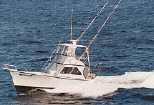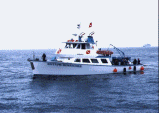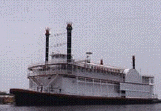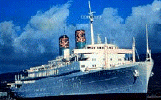Passenger Vessels Access Advisory Committee
Summary of Report
Under the Americans with Disabilities Act (ADA), the Board is responsible for developing and maintaining accessibility guidelines for transportation vehicles. When it originally issued the ADA Accessibility Guidelines for Transportation Vehicles, the Board reserved requirements for passenger vessels pending further study and gathering of information. In August 1998, the Board created the Passenger Vessel Access Advisory Committee to provide recommendations for a proposed rule addressing accessibility guidelines for newly constructed and altered passenger vessels covered by the ADA.
The Committee submitted its final report to the Board in December 2000. This committee explored ways to achieve access in view of various design considerations and made recommendations that the Board will use in proposing guidelines. Identifying the types of vessels to be addressed was also part of the committee’s mission. A wide variety of vessels were taken into consideration, from those used primarily for transportation, such as ferries, to those used for recreation or other purposes, such as gaming boats, cruise ships, and sightseeing boats.
Vessel Classifications
Report Overview
Vessel Classifications
Commercial vessels come in a myriad of sizes and shapes from twenty-foot inflatable dive boats in Hawaii, to 5,000 passenger casino vessels on the Mississippi River, to 1,000 foot oil tankers and container ships at our major ports, to a passenger carrying submarine in the U.S. Virgin Islands. The Coast Guard is responsible for ensuring commercial vessel safety in the U.S. and has divided commercial vessels into various classes. These classes of vessels are divided by type of service and regulated under different subchapters in Chapter 46 of the Code of Federal Regulations (CFR). Examples of types of service include: Tankship; Cargo Vessel; Research Vessel; Offshore Supply Vessel; and Passenger Vessel. Gross Tonnage and numbers of passengers further classify passenger-carrying vessels.
Passenger-carrying vessels incur the majority of public use and are divided into 5 distinct classes. Those classes are:
(1) Uninspected Passenger Vessels (UPVs) less than 100 gross tons carrying 6 or fewer passengers;
(2) Uninspected Passenger Vessels (UPVs) more than 100 gross tons carrying 12 or fewer passengers;
(3) Small Passenger Vessels (SPVs) less than 100 gross tons carrying more than 6 passengers;
(4) Small Passenger Vessels (SPVs) less than 100 gross tons carrying more than 150 passengers or more than 49 overnight; and
(5) Passenger Vessels more than 100 gross tons carrying more than 12 passengers.
In addition, Sailing School Vessels may solicit for students from the public and some Cargo Vessels may carry 12 or fewer passengers on some voyages if they choose.
One of the more confusing issues in describing vessels involves the term “Gross Tonnage”. The most important fact to understand concerning gross tonnage is that this is not a weight measurement, but rather a measurement of volume. Gross tonnage is the total enclosed space or internal capacity of a vessel calculated in terms of 100 cubic feet per gross ton. However, a naval architect making use of regulated exclusion zones and tonnage openings may be able to reduce a vessel’s gross tonnage. This practice may sometimes cause noticeable differences in physical size between vessels that share similar gross tonnage.
The definition of “passenger” for all passenger-carrying vessels is found in 46 United States Code § 2102 (21)(A). It reads: “Passenger means an individual carried on the vessel except (i) the owner or an individual representative of the owner or, in the case of a vessel under charter, an individual charterer or individual representative of the charterer; (ii) the master; or (iii) a member of the crew engaged in the business of the vessel who has not contributed consideration for carriage and who is paid for on board services.” Once passengers are identified, the next step is to determine if the vessel is in commercial service by carrying “passengers for hire”. Passengers for hire are defined as those passengers who have “contributed consideration as condition of carriage on the vessel, whether directly or indirectly flowing to the owner, charterer, operator, agent, or any other person having an interest in the vessel.”
Uninspected Passenger Vessel (less than 100 GT)
 Uninspected Passenger Vessels (UPVs) less than 100 GT are regulated in 46 CFR Subchapter C and are allowed to carry 6 or fewer passengers, at least one of whom is for hire. The U.S. Coast Guard does not formally inspect these vessels, although they may be boarded for safety examinations. Charter sailing vessels, charter fishing vessels and small water taxis are typical representatives of these vessels.
Uninspected Passenger Vessels (UPVs) less than 100 GT are regulated in 46 CFR Subchapter C and are allowed to carry 6 or fewer passengers, at least one of whom is for hire. The U.S. Coast Guard does not formally inspect these vessels, although they may be boarded for safety examinations. Charter sailing vessels, charter fishing vessels and small water taxis are typical representatives of these vessels.
Uninspected Passenger Vessel (more than 100 GT)
 Uninspected Passenger Vessels (UPVs) more than 100 GT are also regulated in 46 CFR Subchapter C and are allowed to carry 12 or fewer passengers, at least one of whom is for hire. The U.S. Coast Guard does not formally inspect these vessels, although they may be boarded for examinations. Large charter yachts, also known as mega-yachts, are the best known representatives of this class of vessels.
Uninspected Passenger Vessels (UPVs) more than 100 GT are also regulated in 46 CFR Subchapter C and are allowed to carry 12 or fewer passengers, at least one of whom is for hire. The U.S. Coast Guard does not formally inspect these vessels, although they may be boarded for examinations. Large charter yachts, also known as mega-yachts, are the best known representatives of this class of vessels.
Small Passenger Vessel (less than 100 GT)
 Small Passenger Vessels (SPVs) less than 100 GT are regulated in 46 CFR Subchapter T and are allowed to carry more than 6 but no more than 150 passengers, at least one of whom is for hire. Subchapter T vessels are also limited to 49 or less passengers overnight. The U.S. Coast Guard formally inspects these vessels for safety and seaworthiness and issues a Certificate of Inspection to those vessels that successfully pass the inspection. There may be no “typical” example of this large class of vessel. Examples range from inflatable dive boats, submarines, aluminum crew boats, ferries, wooden charter fishing boats, and various types of sailing vessels.
Small Passenger Vessels (SPVs) less than 100 GT are regulated in 46 CFR Subchapter T and are allowed to carry more than 6 but no more than 150 passengers, at least one of whom is for hire. Subchapter T vessels are also limited to 49 or less passengers overnight. The U.S. Coast Guard formally inspects these vessels for safety and seaworthiness and issues a Certificate of Inspection to those vessels that successfully pass the inspection. There may be no “typical” example of this large class of vessel. Examples range from inflatable dive boats, submarines, aluminum crew boats, ferries, wooden charter fishing boats, and various types of sailing vessels.
Small Passenger Vessel (less than 100 GT, carrying more than 150 passenger or more than 49 overnight)
 SPVs less than 100 GT, carrying more than 150 passengers or more than 49 overnight, are regulated in 46 CFR Subchapter K. These vessels are allowed to carry more than 6 passengers, at least one of whom is for hire, but are certificated for the carriage of more than 150 passengers or more than 49 overnight. The U.S. Coast Guard formally inspects these vessels for safety and seaworthiness and issues a Certificate of Inspection to those vessels that successfully pass the inspection. Typical examples of this class of vessel are exemplified by large dinner cruise vessels, casino vessels, and larger ferries.
SPVs less than 100 GT, carrying more than 150 passengers or more than 49 overnight, are regulated in 46 CFR Subchapter K. These vessels are allowed to carry more than 6 passengers, at least one of whom is for hire, but are certificated for the carriage of more than 150 passengers or more than 49 overnight. The U.S. Coast Guard formally inspects these vessels for safety and seaworthiness and issues a Certificate of Inspection to those vessels that successfully pass the inspection. Typical examples of this class of vessel are exemplified by large dinner cruise vessels, casino vessels, and larger ferries.
Passenger Vessel (more than 100 GT)
 Passenger Vessels more than 100 GT are regulated in 46 CFR Subchapter H and are allowed to carry more than 12 passengers, at least one of whom is for hire. The U.S. Coast Guard formally inspects these vessels for safety and seaworthiness and issues a Certificate of Inspection to those vessels that successfully pass the inspection. Examples of these types of vessels are the largest casino vessels and ferries as well as cruise ships. (At this time there is only 1 cruise ship under the U.S. flag).
Passenger Vessels more than 100 GT are regulated in 46 CFR Subchapter H and are allowed to carry more than 12 passengers, at least one of whom is for hire. The U.S. Coast Guard formally inspects these vessels for safety and seaworthiness and issues a Certificate of Inspection to those vessels that successfully pass the inspection. Examples of these types of vessels are the largest casino vessels and ferries as well as cruise ships. (At this time there is only 1 cruise ship under the U.S. flag).
Report Overview
The Passenger Vessel Access Advisory Committee (PVAAC) used the ADAAG Review Advisory Committee report as a guide in developing its recommendations. PVAAC applied the recommendations contained in this ADAAG Review report to passenger vessels and then modified those provisions which were problematic when applied to vessels. This summary highlights some of the modifications the committee made. Most committee recommendations apply only to passenger vessels which were are covered by Coast Guard regulations in Subchapters H or K, as compared to smaller vessels which typically fall under subchapters C or T. The report provides scoping provisions, which specify what has to be accessible, and technical requirements, which spell out how access is achieved. The report’s 13 chapters address different areas of access to vessels.
Chapter 1 Onboard Accessible Routes
Exceptions added for vertical access:
- An accessible route is not required to levels located above or below the accessible level in passenger vessels that are less than three decks or that have less than 3,000 square feet per deck.
- An accessible route is not required between decks on a high speed ferry with only two passenger decks where all types of passenger facilities are available on the accessible deck.
- An accessible route is not required to a deck which is less than 300 square feet in size.
Location
Distance provision added by requiring “an accessible route connecting any two points within one or more accessible spaces shall not be more than 300 feet longer than the shortest general circulation path connecting the same two points.”
Elevator Scoping
Exceptions added to allow the use of limited-use/ limited application elevators (LULAs).
- Where each deck of a ferry is less than 3,000 square feet, elevators are permitted to be LULAs.
- Where a passenger vessel is less than 5,000 international tonnage convention (ITC), elevators are permitted to be LULAs.
- Where a passenger vessel is less than 10,000 ITC and multiple elevators are provided, only one elevator is required to comply with standard elevator requirements and all other elevators are permitted to be LULAs.
Wheelchair Lifts
Condition added to allow the use of wheelchair lifts in new construction to provide an accessible route to a deck which is less than 3,000 square feet in size.
Accessible Route Technical Provisions
Width of Route
Where a main deck of a passenger vessel is less than 3,000 square feet in size, the walking surface (and ramp surfaces) shall be permitted to have a clear width of 32 inches minimum.Door Thresholds
Two options were added which provide access over coamings (i.e., high thresholds) which may be required by U.S. Coast Guard regulations, or provided as part of good design practice, for resisting the entry of water. One option, the single ramp slope option, allows the maneuvering space on one side of the door to have a slope matching the ramp slope requirements. The other side would have a maneuvering space at least 48 inches deep and a threshold which is ½ inch high maximum. The second option, the double ramp option, allows the maneuvering space on both sides of the door to have a maximum slope of 1:12. The door in this option must be automatic.Ramp Slope and Landing
Running slope maximums changed to:
- 1:4 if the rise is 3 inches maximum;
- 1:6 if the rise is 6 inches maximum;
- 1:8 if the rise is 9 inches maximum;
- 1:12 if the rise is greater than 9 inches.
Landing length reduced to 48 inches minimum.
Elevators
Two new elevator cab sizes added for standard elevators with centered doors:
| Inside Car, Side to Side | Inside Car, Back Wall to Front Return | Inside Car, Back Wall to Inside Face of Door |
| 54 inches | 65 inches | 68 inches |
| 65 inches | 54 inches | 57 inches |
Limited Use/ Limited Application Elevators (LULAs)
Two exceptions added which allow smaller LULAs.
- Ferries less than 1,000 ITC are permitted to have elevators with a width of 36 inches minimum.
- Passenger vessels less than 1,000 ITC are permitted to have elevators with a width of 36 inches minimum provided they have straight-through travel.
Chapter 2 On/Off Accessible Routes
Scoping
Where passenger vessels are positioned to embark and disembark passengers, at least one means of embarking and disembarking shall comply. (Note: Provisions not written to address embarkation or disembarkation between two or more vessels, a vessel and the water, or a vessel and undeveloped land.)
Components
Means of embarking and disembarking consist of one or more of the following components: a) walking surfaces; b) accessible doors and doorways; c) ramps; d) elevators; e)platform (wheelchair) lifts; f) transfer spans; and g) gangways. (Note: No gangway technical provisions were provided. The committee only provided a methodology to develop such provisions.)
Chapter 3 Egress
Scoping
All space required to be accessible shall be provided with not less than one accessible means of escape complying with Coast Guard requirements. Where more than one means of escape is required by the Coast Guard from any accessible space, each accessible space shall be served by not less than two accessible means of escape. Each required accessible means of escape shall be a continuous and unobstructed way of exit travel to an area of refuge complying with Coast Guard requirements, then if applicable to mustering and lifeboat embarkation locations, or alternatively to the point of disembarking the vessel. An exception was added that provides “where a required means of escape is permitted by the Coast Guard to include a ladder, go through a window, or go through a desk scuttle, the corresponding accessible means of escape is not required.”
Components
Accessible means of escape consist of one or more of the following components: a) walking surfaces; b) doors and doorways; c) ramps; d) curb ramps; e) exit stairways, and f) elevators.
Chapter 4 Emergency Alarms
No major changes from ADAAG Review Report.
Chapter 5 Toilet and Bathing
No major changes from ADAAG Review Report, except provisions added to address outdoor rinsing showers.
Chapter 6 Drinking Fountains and Water Coolers
No changes from ADAAG Review Report.
Chapter 7 Lodging (Passenger)
Door Scoping
Exception added to not require all doors to and within passenger staterooms on a particular deck to have a 32 inch clear opening. The exception would apply where: 1) accessible hospitality rooms are provided, and 2) all passenger staterooms required to be accessible have one 32 inch wide door which provides direct access into an adjacent passenger stateroom.
Room Scoping
Exception added to limit the number of accessible passenger staterooms to 5 percent, where the table from ADAAG Review Report would require more than 5 percent.
Communications Scoping
All passenger staterooms are required to have permanently installed visual alarms where such staterooms are served by audible alarms. For notification devices (which were permitted to be portable), the committee stayed with the table in ADAAG Review Report. Dispersion requirements were provided if notification devices were permanently installed.
Chapter 8 Vehicle Parking
Scoping
Where a ferry does not have public toilets and passengers are not required to leave their vehicles, accessible parking is not required.
Technical
Provisions provided for car parking spaces, van parking spaces, and over-the-road buses, transit, and paratransit bus parking spaces.
Loading Zones
ADAAG Review Report provisions for loading zones were removed.
Chapter 9 Building Blocks
This chapter contains the material which was in ADAAG Review Report chapter 3. The only changes were in the protruding objects section.
Chapter 10 Employee Areas
Employee Cabin Scoping
Two options: a) one and a half (1.5) percent shall be accessible, and b) one percent shall be accessible and where 50 or more employee cabins are provided, an additional one percent of the employee cabins shall be connected to an accessible route and shall have an entry door and bathroom door which is accessible. The provision also includes an exception which exempts vessels without overnight passenger cabins and 15 or fewer employee cabins from having to meet either option.
Exempted Spaces
Limited access spaces (e.g., water tanks and voids), equipments spaces not staffed by service personnel (e.g., sewage treatment pump rooms and communications equipment rooms), machinery spaces (steering gear flats and pump rooms), other spaces (e.g., paint and hazardous material lockers).
Employee Work Areas
Certain employee work areas (not specifically exempted or covered by other provisions) are required to allow a person with a disability to approach, enter, and exit the work area. In addition, some employee work stations within these employee work areas must be designed to allow a person with a disability to approach, enter, and exit the area. (Note: Employee work area is defined as “employee spaces on vessels not open to passengers.” The committee did not provide a definition for work stations.)
Chapter 11 Alterations
Technically Infeasible
Definition for “technically infeasible” changed and related exception was added.
In alterations, where compliance with applicable provisions, as determined by the U.S. Coast Guard, would result in:
- a readmeasured tonnage that changes the regulatory classification;
- changes in the stability of the vessel not meeting the applicable regulatory standards;
- modifications that reduce the integrity (e.g., strength, and fire resistance) of a Class A or B bulkhead or deck; or
- an increase in power load in excess of the existing power supply,
the alterations shall provide accessibility to the maximum extent feasible. Any elements or spaces of the passenger vessel that are being altered and can be made accessible shall be made accessible within the scope of the alteration.
NOTE: Tonnage is not weight, but volume.
Primary Function Areas
Similar exception (as shown above) added to the provision addressing alterations affecting primary function areas.
Major Conversions
Provision added which provides that Coast Guard classified major conversions only require accessibility improvements to the degree required by the alteration provisions of the report.
Chapter 12 C&T (Small Boats)
Coverage
Determines which sailing vessels and power vessels are permitted to meet the small boat provisions instead of the large boat provisions.
Scoping
Addresses only four areas: a) toilet rooms; b) clear deck spaces in major program areas; c) embarkation/debarkation point; and d) accessible routes. Various exemptions modify the provisions covering these areas, including the technical provisions.
Chapter 13 US Coast Guard CFR Report
The chapter contains a report which identifies and compares ADAAG Review Report provisions with Coast Guard and the International Convention of Safety of Life at Sea (SOLAS) requirements.


